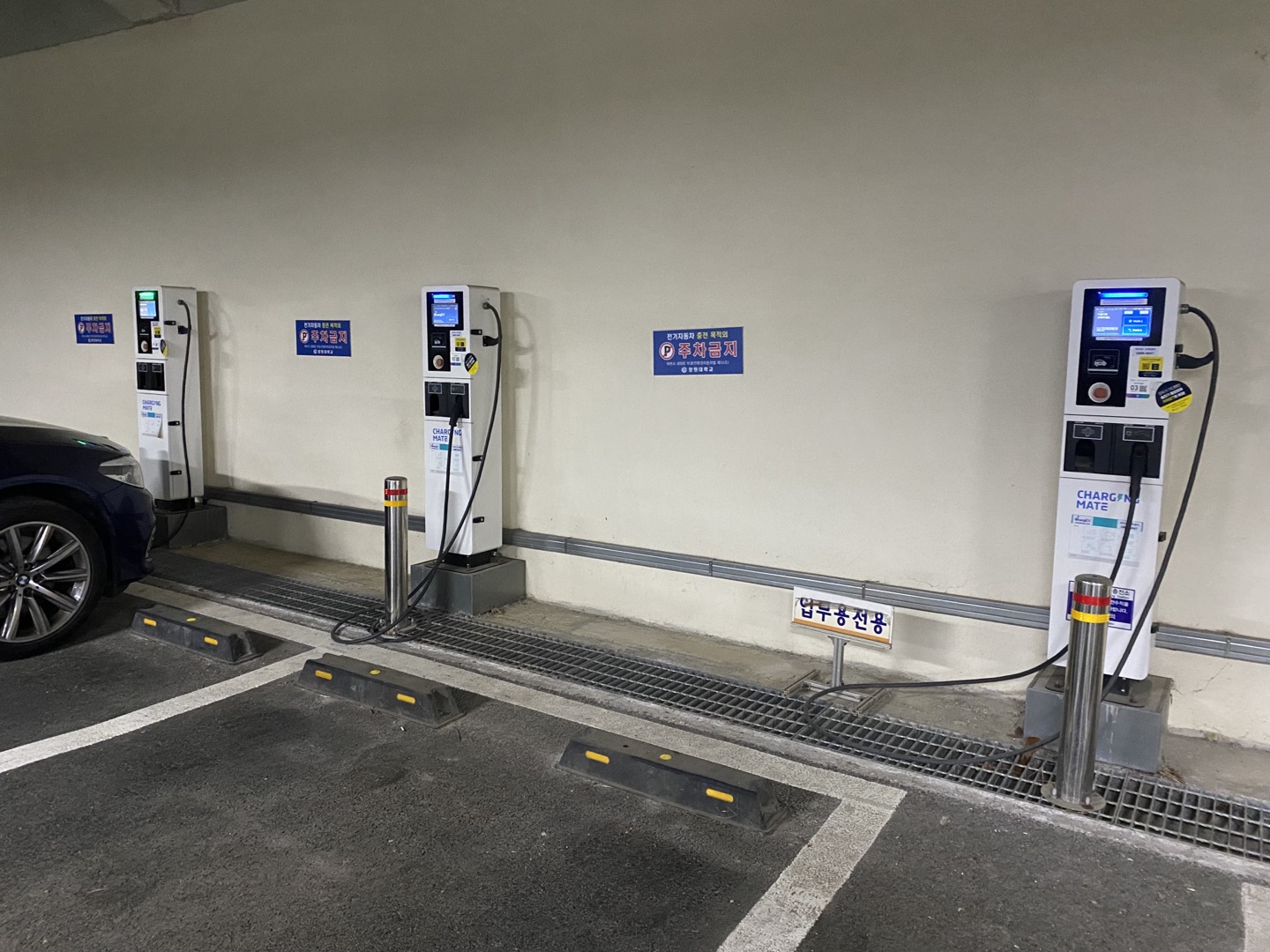 |
| ▲ Electric vehicle charging station located at College of Humanities of CWNU. |
Amid the beginning of the era of the popularization of electric vehicles as the size of the global electric vehicle market has increased 10 times in the past five years, some predict that the eco-friendliness of electric vehicles could be re-evaluated. Before discussing the eco-friendliness of electric vehicles, it is necessary to know the meaning of, 'LCA', which is widely used as a measurement when evaluating the eco-friendliness of the entire product or system process. Life Cycle Assessment (LCA) is a technique that quantifies the use of energy and mineral resources throughout the processing, assembly, transportation, use, and disposal of products or systems, identifies their potential adverse environmental impacts, assesses and improves environmental impacts. Based on LCA, it is known that hybrid cars emit less greenhouse gas than electric vehicles. Electric vehicles are considered an essential means of carbon neutrality because they do not consume fossil fuels while driving, but controversy over eco-friendliness has rarely subsided due to the generation of carbon in the battery sector, which is a key component to operation. At the same time, some point out that the cost of maintaining electric vehicles is much higher than that of internal combustion locomotives, which makes them less economical.
"Although electric vehicles have no emissions while driving, mining lithium, cobalt, and manganese raw materials and the production and disposal of batteries cause disasters to the environment," the British Financial Times said in early August 2021. Lithium-ion batteries, which are essential for electric vehicles, are made of rare earth materials such as lithium, cobalt, and manganese, with harmful by-products generated from mining such raw materials, and air pollutants such as sulfur oxides are produced in the smelting stage. Analysts say that electric vehicles should be operated for a long time to offset the emission of a significant amount of carbon in the process of battery cell production. According to a study by Scholars Christoph, Hans Dieter and Hans Werner in Germany, 10,875 to 14,625 kilograms of carbon dioxide are emitted to make a 75 kilowatt battery for Tesla's electric vehicle. To produce one battery, 23,000 to 32,000 pounds of carbon dioxide is generated, which is not the end of process. After the first electric vehicle battery was produced, electricity to charge was generated by burning coal, oil, and gas in thermal power plants. It was also pointed out that a great amount of carbon is generated in the process of transporting raw materials. According to the Financial Times, cobalt, a key raw material for batteries, travels more than 32,186 kilometers from mining in the Democratic Republic of Congo in Africa to be procured by automakers in the form of batteries.
Meanwhile, the Ministry of Environment announced that some amendments to the Enforcement Decree of the Act on Resource Circulation of Electrical and Electronic Products and Automobiles (abbreviated as the "Resource Circulation Act") were approved at a Cabinet meeting on June 29 and will take effect on July 6. The revision calls for entrusting the operation of the Future Waste Resource Base Collection Center (Gyeonggi Siheung, Chungnam Hongseong, Jeonbuk Jeongeup, and Daegu Dalseo) set up by the Minister of Environment to collect, store and recycle waste batteries for electric vehicles.
In addition, the Korean government has announced "2050 Carbon Neutrality." The "2050 Carbon Neutrality" is a concept that reduces greenhouse gas emissions from human activities as much as possible, and removes (CCUS, Carbon Capture,.Utilization and Storage: technology to capture, store, and utilize carbon dioxide) to zero. In other words, the amount of carbon that is emitted and absorbed is the same, so that the net emission of carbon is zero, which is also referred to as Net-Zero. Taking this year as the first year of implementation of, "2050 Carbon Neutrality," the government is pushing for a shift in carbon neutrality across all sectors of society. Accordingly, it is planning to increase the number of electric vehicles by 200,000 and to supply 160,000 electric chargers by expanding charging infrastructure and demonstrating new technologies such as wireless charging and battery exchanges. While policies to revitalize and encourage people to use electric vehicles are actually being promoted, many questions still remain on the eco-friendliness of electric vehicles. The actual (2050 Carbon Neutrality) will be achieved only when policies are implemented to solve the problems of battery production, transportation, and waste battery of electric vehicles. This is the moment when Korea's efforts are needed accordingly.
By Shin Jeong-eun,cub-reporter jes203id@gmail.com
<저작권자 © The Campus Journal, 무단 전재 및 재배포 금지>

 Shrinkflation, Consumer Deception
Shrinkflation, Consumer Deception




